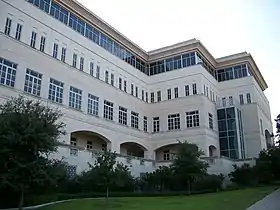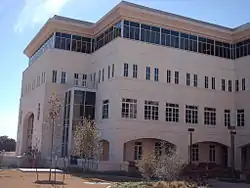University of Texas at San Antonio College of Sciences
The College of Sciences at the University of Texas at San Antonio is a college in research and science education. The college hosts more than 5000 students enrolled in fifteen undergraduate[1] and sixteen graduate programs.[2] The seven departments employ 286 tenure and non-tenure track faculty members.[3] Students are exposed to collaboration through programs with local external research institutions including UT Health Science Center, Southwest Research Institute and the Southwest Foundation for Biomedical Research.
 Biotechnology Sciences and Engineering Building | |
Parent institution | University of Texas at San Antonio |
|---|---|
| Dean | David Silva |
Academic staff | 286 |
| Students | 4,715 |
| Location | San Antonio, TX |
| Website | https://www.utsa.edu/sciences/ |
Department
There are various degrees offered by 7 major programs at the College of Sciences.
Biology
The Biology department conducts research in a wide variety of areas such as Cell and Molecular Biology, Microbiology and Immunology, Neurobiology, and Plant Biology.[4] This includes two of the college's focus areas of neuroscience and infectious diseases. The largest department in number of faculty members and students, biology accounts for 25 percent of the College’s funding.
Chemistry

The Chemistry department conducts active research programs under the major sub-disciplines of organic chemistry, biochemistry, inorganic chemistry, analytical chemistry, materials chemistry, and physical chemistry as well as through interdisciplinary collaborations. The search for a molecular-scale understanding of chemical reactions and properties of nature underlie the research programs of the departmental faculty.
Computer Science
The Computer Science department is one of the departments at the University that does research in many areas including compilers, programming languages, software engineering, networking, bioinformatics, algorithms, artificial intelligence, cyber security, high-performance computing, computer vision, and distributed computing. The department has doubled in size and in funding over the last few years, and now has 24 faculty members, computer labs, and many computing facilities and wireless networks.
Environmental Sciences and Ecology
The Environmental Sciences and Ecology Department offers both undergraduate and graduate students research opportunities in areas such as Aquatic Science, Conservation and Restoration Ecology, and Natural Resources and Wildlife Management.[5]
Geological Sciences
The Geological Sciences department has been at UTSA from the earliest days of the University's history. Its research facilities include biogeochemistry, environmental microbiology, hydrogeology, isotope geochemistry, micropaleontology, remote sensing, spatial analysis, and X-ray diffraction.
Mathematics
The Mathematics department has research scholars in ordinary differential equations, partial differential equations, functional analysis, numerical analysis, algebra, statistics, analytic number theory, applied mathematics, and mathematics education.
Physics and Astronomy
The Physics and Astronomy department does research including in the focus area of nanotechnology. The department provides students the chance to interact with scientists in experimental physics, theoretical physics, space physics, and astrophysics and to collaborate with scientists from the Space Science and Engineering Division at Southwest Research Institute.
Research
Of the $34 million expended on research for the fiscal year 2008 in the University of Texas at San Antonio, the College of Sciences received 71 percent. Allowing students to participate in the growth of their fields through research enables them to succeed both in academia as well as in the applied sciences.
The 227,000-square-foot (21,100 m2) Biotechnology, Sciences, and Engineering Building is one of the largest research-related educational centers in Texas. The building includes 70 research and instructional laboratories that facilitate interdisciplinary research and collaboration between scientists and engineers.
Centers & Institutes[6]
- Center for Advanced Computing and Network Research
- Center for Research and Training in the Sciences (CRTS)
- UTSA Brain Health Consortium (BHC)
- San Antonio Cellular Therapeutics Institute (SACTI)
- Center for Innovative Drug Discovery (CIDD)
- Center for Water Research , Sustainability and Policy (IWRSP)
- NASA MIRO Center for Advanced Measurements in Extreme Environments (CAMEE)
- Institute for Cyber Security (ICS)
- Center for Infrastructure Assurance and Security (CIAS)
- San Antonio Institute for Cellular and Molecular Primatology (SAICMP)
- South Texas Center for Emerging Infectious Diseases (STCEID)
- UTSA Neurosciences Institute
- Consortium on Nuclear Security Technologies (CONNECT)
- Kleberg Advanced Microscopy Center (KAMC)
Student organizations
There are many science organizations on campus.
- Beta Beta Beta Biological Honor Society
- Mu Alpha Tau Mathematics Honor Society
- Upsilon Pi Epsilon National Computing Science Honor Society
- Chemistry Club - American Chemical Society Student Affiliate Chapter
- Graduate Society of Physics Students
- Society of Physics Students
- Society of Undergraduate Neuroscience
- Statistics Club
- Macintosh Exchange Activity - for students interested in automotive engineering
- Physical Therapy Society
- Physician Assistant Society
- Pre Nursing Society - for engineering honors students
- Pre Dental Society
- Pre-Medical Society
- Pre-Pharmacy Student Organization
- Society of Mexican-American Engineers and Scientists
- Alpha Epsilon Delta - Pre-medical Society
References
- "Undergraduate Programs | UTSA College of Sciences". www.utsa.edu. Retrieved 2020-09-12.
- "Graduate Programs | UTSA College of Sciences". www.utsa.edu. Retrieved 2020-09-12.
- "About | UTSA College of Sciences". www.utsa.edu. Retrieved 2020-09-12.
- "Research | UTSA Department of Biology". www.utsa.edu. Retrieved 2020-09-12.
- "Research | UTSA Department of Environmental Science and Ecology". www.utsa.edu. Retrieved 2020-09-12.
- "Centers & Institutes | UTSA College of Sciences". www.utsa.edu. Retrieved 2020-09-12.
